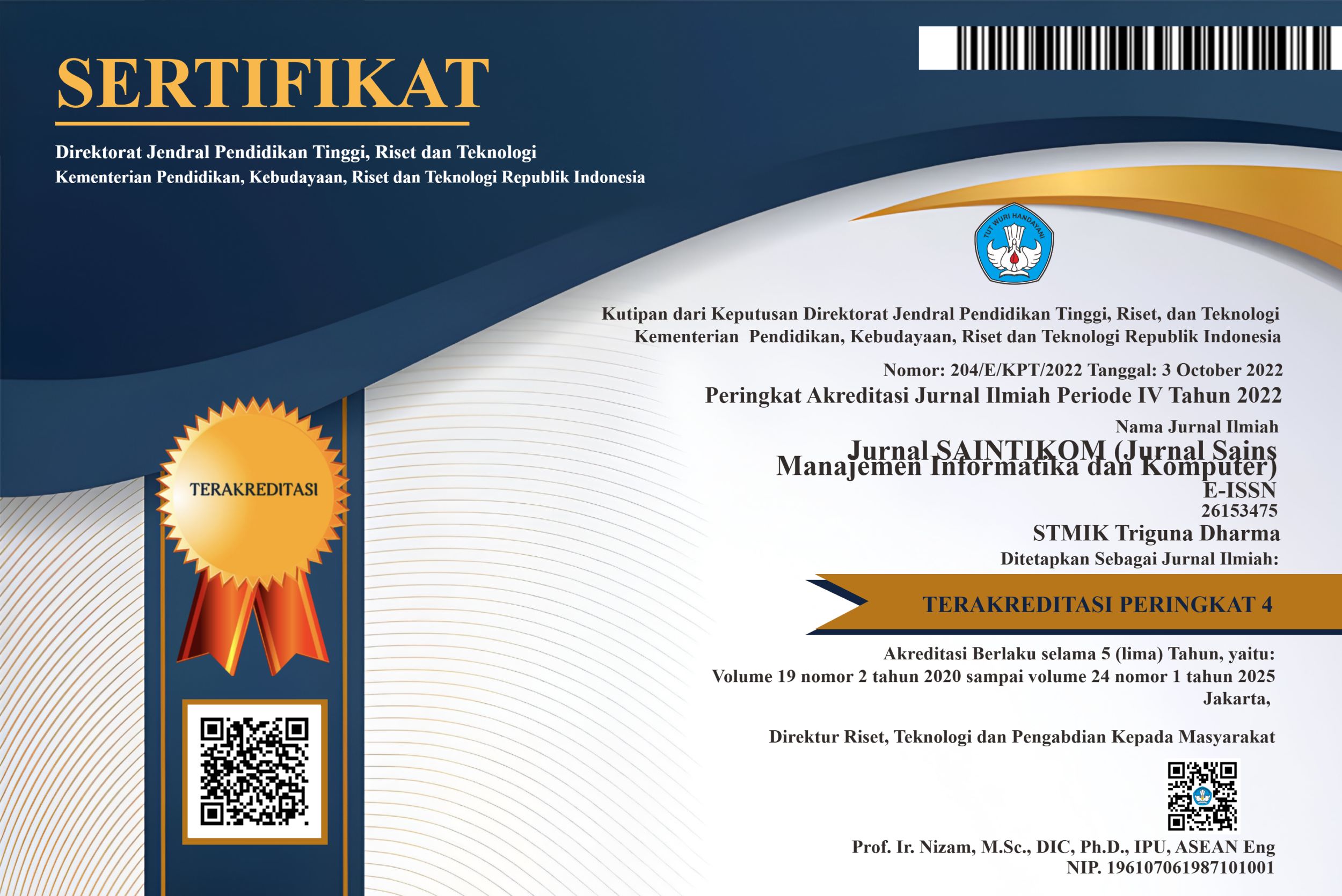Analisis Daya Tahan Keamanan Data Pada Steganografi Berbasis Teks Dalam Struktur Kalimat Bahasa Indonesia
DOI:
https://doi.org/10.53513/jis.v22i2.8773Keywords:
Data Security, Text Steganography, Sentence Structure, Attack DurabilityAbstract
Data security in text-based steganography needs to be analyzed in depth to ensure the sustainability and security of the method. The purpose of this research is to analyze the durability of data security in text-based steganography. The analysis approach consists of steps to identify and evaluate the vulnerability of text steganography methods with Indonesian sentence patterns. The first step is to review previous relevant work in this field to understand the vulnerabilities that have been identified previously. The text insertion model carried out is dictionary-based as many as 1,929 words which are divided into seven-word classes that correspond to sentence patterns in Indonesian, namely adj (adjective), adv (adverb), nom (noun), num (numeral), par (particle), pro (pronominal) and ver (verb). Each word class is organized into sentence patterns and each has the same bit length of eight bits. The results of the durability analysis show that input data with a length of one word still can be hacked if the message insertion process with a choice of short sentence patterns. Whereas with a choice of sentence patterns that are more than two words it will start to be difficult to hack and even cannot be hacked because the number of possibilities is very large and even infinite or infinity.
References
J. Y. Babys, Kusrini, and Sudarmawan, “Analisis Aspek Keamanan Informasi Jaringan Komputer ( Studi Kasus : STIMIK Kupang ),†Semin. Nas. Inform. 2013, 2013.
R. Fanry Siahaan, M. Zarlis, and B. B. Nasution, “Performance analysis of steganography alphanumeric text in the text based on Indonesian linguistic,†IOP Conf. Ser. Mater. Sci. Eng., vol. 420, no. 1, p. 012123, Oct. 2018, doi: 10.1088/1757-899X/420/1/012123.
K. Wang and Q. Gao, “A Coverless Plain Text Steganography Based on Character Features,†IEEE Access, 2019, doi: 10.1109/ACCESS.2019.2929123.
J. Yang, P. Liu, and S. Li, “A common method for detecting multiple steganographies in low-bit-rate compressed speech based on bayesian inference,†IEEE Access, 2019, doi: 10.1109/ACCESS.2019.2939629.
N. Wu et al., “STBS-Stega: Coverless text steganography based on state transition-binary sequence,†Int. J. Distrib. Sens. Networks, 2020, doi: 10.1177/1550147720914257.
A. Ramadhani, “KEAMANAN INFORMASI,†Nusant. - J. Inf. Libr. Stud., 2018, doi: 10.30999/n-jils.v1i1.249.
X. Duan, D. Guo, N. Liu, B. Li, M. Gou, and C. Qin, “A New High Capacity Image Steganography Method Combined with Image Elliptic Curve Cryptography and Deep Neural Network,†IEEE Access, 2020, doi: 10.1109/ACCESS.2020.2971528.
Y. Huang, C. Liu, S. Tang, and S. Bai, “Steganography integration into a low-bit rate speech codec,†IEEE Trans. Inf. Forensics Secur., 2012, doi: 10.1109/TIFS.2012.2218599.
N. Hamid, A. Yahya, R. B. Ahmad, and O. M. Al-Qershi, “Image steganography techniques: an overview,†Int. J. Comput. Sci. Secur., 2012.
G. C. W. Ting, B. M. Goi, and S. W. Lee, “Robustness security of data hiding for H.265/HEVC video streams,†Int. J. Recent Technol. Eng., 2019, doi: 10.35940/ijrte.C1026.1083S19.
F. Q. A. Alyousuf and R. Din, “Analysis review on feature-based and word-rule based techniques in text steganography,†Bulletin of Electrical Engineering and Informatics. 2020. doi: 10.11591/eei.v9i2.2069.
R. Gawade, P. Shetye, V. Bhosale, and P. N. Sawantdesai, “Data Hiding Using Steganography For Network Security,†Int. J. Adv. Res. Comput. Commun. Eng., 2014.
S. Edward Jero and P. Ramu, “Curvelets-based ECG steganography for data security,†Electron. Lett., 2016, doi: 10.1049/el.2015.3218.
A. A. Fikhri and H. Hendrawaty, “Implementasi Steganografi Text To Image Menggunakan Metode One Bit Least Significant Bit Berbasis Android,†J. Infomedia, 2018, doi: 10.30811/jim.v3i1.623.
H. Annur, “Klasifikasi Masyarakat Miskin Menggunakan Metode Naive Bayes,†Ilk. J. Ilm., 2018, doi: 10.33096/ilkom.v10i2.303.160-165.
I. G. N. K. Putrayasa, “Jenis - Jenis dan Pola Kalimat Bahasa Indonesia,†Https://Repositori.Unud.Ac.Id/Protected/Storage/Upload/Repositori/C5Af5469574856E21718C34882583925.Pdf, 2016.
A. Hasan, “Tata Bahasa Baku Bahasa Indonesia,†Dep. Pendidik. dan Kebud. Republik Indones., 2007.

















